Header: Male Tilapia. Photos by Gunther Schmida
Being a keen sherman and having a passion for the environment, the issue of pest fish is very close to my heart. Tilapia is one of the most common and destructive pest fish in South East Queensland (SEQ), having taken up residence in many of our local waterways and reservoirs.
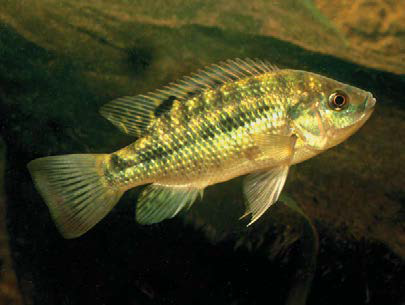
Growing to a maximum length of 40 cm, tilapia fiis one of the toughest and most resilient fish species in our waterways. They can survive in temperatures from 80C to 420C, preferring still or slow moving water in a variety of habitats, including reservoirs, lakes, ponds, rivers, creeks, drains, swamps and even tidal creeks and estuaries. To my surprise and also disappointment, my first encounter with a tilapia was in Townsville in a saltwater creek, 50 metres from the ocean and with views of Magnetic Island.
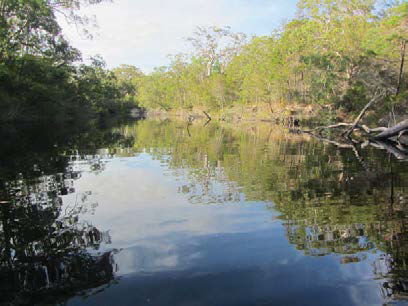
There are two species of tilapia that have escaped into the wild in Queensland: Mozambique Tilapia (Oreochromis mossambicus) and Spotted Tilapia (Tilapia mariae). Of the two, O. mossambicus is the most common and the main one found in SEQ. Generally, most O. mossambicus are olive to yellow in colour on the dorsal area, with silvery sides and a whitish belly – although breeding males are much darker, with red tips on their fins. Being part of the Cichlidae family, they were a sought after aquarium fish but also were irresponsibly released into local waterways.
One of the first recorded sightings of tilapia within SEQ was in Tingalpa Reservoir in 1977. Since then, populations have been recorded in Maroochy, North Pine, South Pine, Caboolture, Brisbane, Bremer, Logan, Stanley and Albert Rivers, as well as connected creeks and drainages throughout the Gold Coast, Brisbane and Deception Bay.
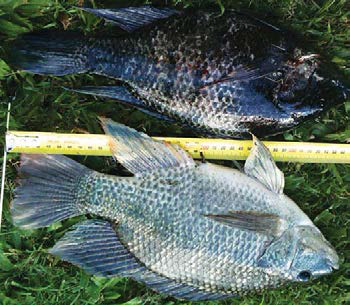
Pine, Wivenhoe, Somerset, Maroon and Moogerah Dams and also Lake Kurwongbah. Unfortunately due the recent flooding of most of our major waterways, tilapia have now spread to many more dams, waterholes, creeks and rivers. As many Land for Wildlife properties adjoin or contain waterways, it is likely that tilapia could now exist within a water body on your property.
Male tilapia build circular breeding nests in clusters of sand or muddy riverbeds. These nests should not be confused with the native Eel-tailed Cat fish, Tandanus tandanus (pages 4-5), which build fewer, larger nests often in gravelly riverbeds and are religiously patrol. Tilapia are mouth- brooders, meaning, once deposited in nests, females hold their eggs (100-1700 per female) for 3-5 days and larvae for 10- 15 days in their mouth until they are big enough to survive most predators. For this reason, populations can explode quickly, as unlike most other native fish species, their survival rate is very high.
The impacts of tilapia are widespread and include environmental issues such as decreased water quality, introduction of disease, competition for resources, predation of native fish and economic and recreational impacts such as reduced value of conservation areas and decreasing the catch of recreational and commercial sherman. These impacts are why tilapia are declared noxious in Queensland under the Fisheries Act 1994 (Fisheries Regulation 2008). It is unlawful to have noxious fish (alive or dead) in your possession, or to use them as bait, and it is illegal to place or release noxious fish (alive or dead) into Queensland waterways. Penalties of up to $200,000 may apply.
Although the presence of pest fish can potentially have devastating results, it is important to know that they often come hand-in-hand with already degraded waterways. Regulation of waterway flow, fish barriers, pesticide runoff , exotic weeds, over exploitation of fish stocks and removal of bankside vegetation are all threats to the health of a waterway, potentially increasing the risk of a noxious fish population. Revegetating riparian areas, as well as stabilising banks and creating in-stream habitat will improve the overall health of the waterway and competition for noxious fish.
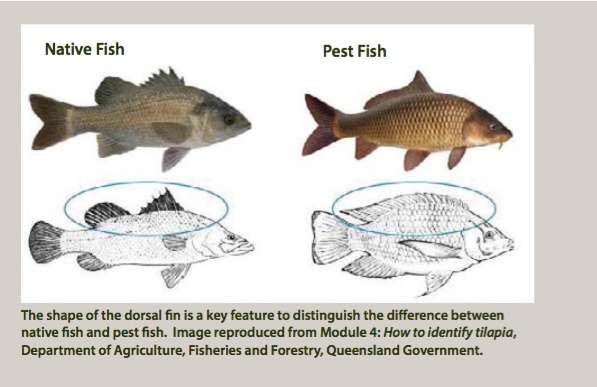
Even though tilapia are noxious fish they can still be targeted to reduce numbers. By law, they have to be humanely disposed of and placed well above the high watermark, immediately after capture. This is in case a female with a brood of eggs in its mouth is caught, since these eggs can be viable for up to a day out of water. Simple fishing methods, using bread or prawns as bait, can be used to catch tilapia. They are a fun and safe fish for children to catch and are a good way to educate people of the affects that pest species have on the natural environment.
It has proven extremely difficult and expensive to eradicate pest fish once they have become established in the wild.
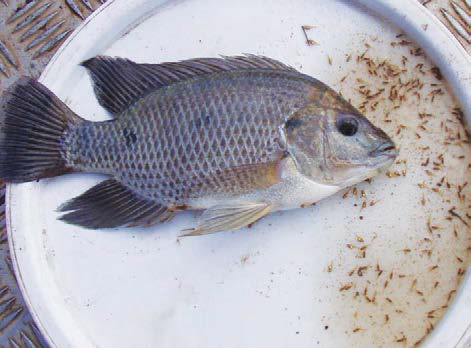
Therefore, it is vital to prevent noxious pests such as tilapia from entering or spreading further throughout our waterways. Governments are trying to stop the spread of tilapia and other noxious fish through an education and identification program. An easy way to distinguish a pest fish from a native fish is that the majority of pest fish have a continuous dorsal fin, while native fish have a dent or gap separating the front of the dorsal fin from the rear.
If you suspect you have tilapia or any other noxious fish in a waterway on your property, report sightings to the Department of Employment, Economic Development and Innovation (DEEDI) Customer Service Centre by phoning 13 25 23, emailing [email protected] or filling out the Pest Fish Reporting Form online at www.fisheries.qld.gov.au. The State Government has a fact sheet on how to identify and report sightings of tilapia, which can be accessed through http:// tinyurl.com/kpkuvft
Article by Cody Hochen Land for Wildlife Officer Brisbane City Council
References and Further Reading
Allen GR, Midgley SH & Allen M (2002) Field Guide to the Freshwater Fishes of Australia. Western Australian Museum.
Queensland Museum (2007) Freshwater Fishes of Greater Brisbane Region – A Queensland Museum Wild Guide. Queensland Museum.
Queensland Museum (2007) Wildlife of Greater Brisbane. Queensland Museum.
https://www.daf.qld.gov.au/business-priorities/fisheries/recreational/recreational-fishing-rules/noxious-fish

retail wet fish mungers that have whole tilapia are exempt????? the local often has them for sale..
Hi Brian. It is illegal to have Tilapia in your possession in Queensland. This includes selling or eating Tilapia. If you see Tilapia for sale in any fish stores in Queensland, please phone Biosecurity Queensland on 13 25 23 or call the Fishwatch Hotline on 1800 017 116.
Wouldn’t it be beneficial to eat Tilapia. It’s a good tasting fish that gets sold overseas on many menus. This would encourage recreational fishermen to help eradicate the pest.
We pretty much have eradicated all our native fish with overfishing.
I have been trying to get a few fishing sites to support eating these pests.
No one seems to be interested.
Filet & put bodies in disposal bins.
m y concern is the Tiiapa in the Mary and Burnett river which there is no attempt of control or monitoring will in our life time be the end of the Lung fish which has been in these rivers since the reign of the dinosaurs
Today I will I saw the pest being caught and taken home to be eaten ,,this was out of the Mary river ,,,,
This must be allowed to happen and people will keep catching them including me ,,,it’s to late now to try and control it lets over fish it to give native fish a chance,,,it will not be controlled with present laws plain stupid ,,
To me it seems the approach/stance that has been employed isnt successful with high penealties for being caught with tilapia in posession. Wouldnt it be mote beneficial to educate and encourage fishermen, women to catch these without adverse effects in place as witg other introduced species. Alot of asian countries eat these fish as a staple part of there diet so no bag limits would be needed to be set. no size limit to be set, no catch and release thats wheb you get penalised. The spread and infestation needs to stop but a practucal reasonable approch needs to be taken. Look at what the current system has achieved, total spread of the fish in queensland waterways already stop the scaremongering and start a proactive public initiative
I agree with what you have said…a far more sustainable way of control is required as to date, the rules are so ridiculous that the nutjob who invented such high penalties and rules, has successfully increased the influx and reproduction of these pests. My hubby is Asian and he does not understand why these penalties are so high, when many times we go fishing and see little burned out fires beside the lakes and rivers, where the Asian fishermen have obviously caught and cooked these fish…because there are bones left in the ashes.
How about we come up with more sustainable ideas in how to control them without the ridiculously high penalties which are basically forcing any fishermen to toss back these fish so they don’t get caught with them in their possession…which only adds to the problem.
Anyone with a good idea, please share it.
Are there tilapia in Baffle Creek
Without a doubt Australia is the most benign continual environment for introduced and or feral species: inter alia
Dingo, dogs, Fox, Horse, Camel, Donkey, CATS, carp, roach, tench, trout, TILAPIA, CANE TOADS, mimosa, LANTANA, giant rats tail etc etc.
Some one must be responsible for the mess. That someone is US via our governments.
I have no objection to paying an environmental tax if it will lessen the impact on these immigrants.
No! We can’;t simply send them offshore to detention. We must do something now. We must finance the governments (all three levels) to enable them to really do something about it.
$500 million to an obscure Reef watch team is not good enough and won’t do a ‘darn’ thing. The reef is only one small patch.
Any one who calls trout and salmon a noxious feral pest is crazy in the extreme. It took massive effort to get them established in suitable waters in Australia for the benefit of Anglers
Hi guys, I am quite stressed that we possibly have talipia living in our rather large house pond. I have no clear idea how they got there…It is possible kids picked up babies a few years back rescuing guppies from a puddle near south pine river after heavy rain. Otherwise we do buy feeder fish regularly from a pet produce. It appears there are possibly up to 8 and I have only just noticed due to their ‘sudden large size’. If they are I need to destroy. However if they are river bream I don’t want to.. Is there someone that can assist me to classify? We have caught one and have photos. Would appreciate some assistance. For a non-fish expert they all look rather similar.
Hi Alisha
You can take a photo of the fish and send it to the Queensland Museum – they will identify it for you. Their online form is easy to use https://www.qm.qld.gov.au/Find+out+about/Ask+an+Expert/Ask+a+Question#.XT_WAOgzZaQ
Cheers.
How stupid , you want to get rid , but you won’t let us eat them , very sensible
Unfortunately the way human nature is, if there is a value on a pest fish (e.g. its good to eat) then people will spread it around further than they currently are for reasons such as not having to go so far to catch one next time, or when my local gets fished out, i can go to the next place to catch a feed. The bottom line is there is zero evidence to show that recreational, or even commercial fishing, will make any difference to the numbers in open waterways (e.g. rivers). It might help short term for small closed waters like a urban lake or ornamental pond but that effect will be short lived until they breed back up as soon as the fishin pressure is released. So the only logical solution is to do whatever is needed to reduce the spread until a control option (e.g. virus) is found.
Theres an app you can get a free week trial before you pay $30.99 annually and it’s called picture fish, any picture that you take or upload onto it, it will tell you what fish/fishes it is or can be and has more information about it. Has a few other features but that’s the main function and it’s awesome for someone like myself who can’t tell any of the fish apart 🤣🤣
We need to update the facts, afte rcatchina 51 cm 2.9 Kg talarpia in the Woralong dam today
hi if you catch a tilapia in queensland. after you kill it can u keep the fish to feed to your pet fish that you have at home
Hi Jerry. It’s our understanding of the regulations that pest fish, once removed from the water, cannot be returned to the water. We recommend humane disposal and what you do with it after that is up to you.
Hi everyone, I live in browns plains brisbane & looking to jelp catch these tilapia, any recommendations?